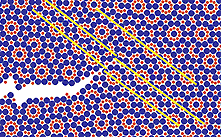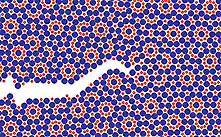Knowing how and why materials fracture means finding out what's going on at the atomic scale, says Hans-Rainer Trebin.
Knowing how and why materials fracture means finding out what’s going on at the atomic scale, says Hans-Rainer Trebin.
Solid material is damaged mechanically in two ways. Either it loses shape permanently by bending (plastic deformation), or it breaks into pieces. In daily life a shattered glass is a nuisance. In technological systems rupture may become catastrophic, leading to explosions of steam-ship boilers in the 19th century, or to the leakage of pressure vessels in modern nuclear reactors, the sudden breakage of welded Liberty ships during World War II, or apparently to the crash of the space shuttle Columbia on 1 February 2003. On a smaller scale, the integrated circuits in computer chips are limited in their reliability by microcracks that interrupt contacts.
For material scientists such as myself the challenge is to develop solids that can sustain large forces without fracture. Our understanding of how materials fracture also helps when ’cracking’ materials deliberately, for example to pulverise gall- or kidney-stones by ultrasound without surgery.
So how do material scientists investigate cracks? Experimentally, in fractography, researchers study the fracture surfaces ’post mortem’ by using light or electron microscopes. In transparent plastics we can observe the stress around the cracks directly from the stress-induced birefringence of the material - seen as a colourful pattern. However, this tells us nothing of the dynamic processes at the atomic level. The elastic continuum theory - which looks at the solid from such a distance that the atoms are no longer resolved and the solid appears as continuous matter - provides some insight. But, not all processes influencing macroscopic behaviour are accessible to continuum theory.
Given a fixed cleavage plane, for example, the direction in which the crack propagates depends on the detailed geometry of the atomic bonds. Cracks are therefore a multi-scale phenomenon and their study requires the appropriate scientific tools such as molecular dynamics (MD), in which attention focuses on the individual atoms.
For a given structure, we know the initial positions or coordinates of the atoms from experimental analysis. In MD, computer algorithms then solve Newton’s equations of motion for each single atom under the influence of its neighbours and of outside sources. It amounts to a numerical experiment, where all observables - atomic positions, velocities, energies - are accessible, unlike for a real experiment.
To observe crack dynamics, we need to study large numbers of atoms - at least tens of thousands - which in turn means solving large numbers of equations, one for each atomic coordinate. To analyse the results, we need to be able to visualise single atoms. In two dimensions the atoms are shown directly, colour coded according to their kinetic or potential energy (Fig 1). To look inside a three-dimensional solid, only the atoms that are most involved in the fracture are plotted, singled out by their enhanced energy values.
Fig 1. Molecular dynamics simulation of crack propagation in a two-dimensional model quasicrystal, with crack tips and emitted sound waves

My group at Stuttgart University is using large-scale MD simulations to study the structure, dynamic and mechanical properties of a new class of ordered intermetallic alloys, the quasicrystals. Quasicrystals are distinguished by the fact that both their crystal shapes and their electron- or X-ray diffraction patterns show five-, eight-, 10- or 12-fold symmetry. Typical examples are icosahedral Al-Mn-Pd or decagonal Al-Ni-Co. The atoms in a quasicrystal are arranged in flat monolayers, just as in periodic crystals. However the spacings between these layers are not all the same and occur in a quasiperiodic (not a periodic) sequence.
In the vicinity of a crack tip large stresses are acting on the material. They cause parts of the crystal, adjacent to the tip, to glide past each other successively by a dislocation motion. The sequential shift of crystal planes through dislocation motion causes a plastic deformation (Fig 2). Whereas in a periodic crystal the two crystal ’halves’ fit well together after the glide, misfits remain in a quasicrystal and give rise to a stacking fault. Along this fault the material is weakened. The crack follows the fault, ie it occurs after the dislocation (the interrupted yellow lattice planes in Fig 3). This is a major crack propagation mechanism in quasicrystals.
Fig 3. The sequence of crack tip propagation in a quasicrystal



Quasicrystal research is very active in France, Germany, Japan and the US, and applications are expected within the next few years as low-friction, anticorrosive, heat resistant and non-adhesive coatings. Recently, various research groups have been able to embed hard nanosized quasicrystals in a ductile aluminium matrix. The combination of plasticity and hardness results in an extremely tough material which - also owing to its light weight - is likely to be useful in aerospace technology.
For a qualitative overview of crack phenomena researchers frequently restrict themselves to two-dimensional crystals. Brad Holian’s group from the Advanced Computing Laboratory at Los Alamos, US, started with a strip of 400,000 atoms.
They inserted a line-like seed crack, pulled the sample sides apart and studied how the crack branched and emitted dislocations. The finiteness of the system requires many tricks. For example, the sound waves of the crack are reflected from the system boundaries and threaten to melt the solid. Thus they have to be damped away artificially.
A problem for all computer simulations such as this is running time. Since one computational time step corresponds in reality to a femtosecond, simulations are restricted to very short times, nanoseconds at best.
In an attempt to increase system size and running times, Priya Vashishta and Aiichiro Nakano’s group at the Concurrent Laboratory for Materials Simulations at Louisiana State University apply multiple parallel machines with over 1000 processors, each handling a certain domain of the solid. The researchers select multiple scales for the time steps: long ones for regions outside the crack core where any changes are slow, short ones at the main sites of action. In this way they are able to simulate fracture of ceramics, in crystalline, amorphous and heterogeneous form.
For example, they have recently used this approach to follow rupture of SiC fibers embedded in a Si3N4-matrix where dissipation is enhanced due to fibre-matrix friction. The number of atoms was 1500m, roughly equivalent to a cube of 200 nm side length.
Considerable amounts of data are produced in multi-million- and billion-atom simulations, which are processed by separate parallel graphics computers. In addition to making their simulations bigger, researchers are devoting a lot of time to obtaining realistic interactions between the atoms. Michael Marder’s group at the University of Texas simulated fracture of pure silicon with dozens of empirical force laws from the literature. All of the simulated crystals could be deformed more easily and cracked less than in experiments on real crystals.
Although tremendous insight has been gained from molecular dynamics simulations, there are two shortcomings. Besides requiring large systems and long running times, these simulations still do not define precisely the interactions at the crack tip. One way around these problems are costly hybrid multiscale calculations. Far away from the crack tip, elastic continuum theory applies; closer to the tip we use MD simulations; while directly at the tip we calculate the electronic wave functions of the atomic bonds. Connecting ’handshake’ regions are required between these different domains.
Numerical simulations have become a powerful tool with which to study the origin of material properties at the atomic level. In the near future, tera- and petaflop computers will also be helpful in suggesting ways of tailoring materials to achieve the desired properties.
Source: Chemistry in Britain
Acknowledgements
Many members of my group were involved in the crack propagation studies. In particular I want to thank Christoph Rudhart for preparing the figures.
Hans-Rainer Trebin
References
1. C. Janot, Quasicrystals: a primer. Oxford: Clarendon Press, 1994.
2. R. Mikulla et al, Phys. Rev. Lett., 1998, 81, 3163.
3. J.-M. Dubois, Mater. Sci. Eng., 2000, A294-296, 4.
4. S. J. Zhou et al, Phys. Rev. Lett., 1996, 76, 2318.
5. C. L. Rountree et al, Ann. Rev. Mater. Res., 2002, 32.
6. M. Marder, Comput. Sci. Eng., September/October 1999, p 48.
7. F. F. Abraham et al, MRS Bulletin, 2000, 25, 27.






No comments yet